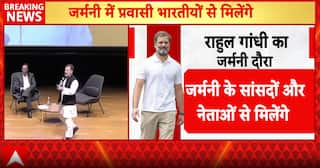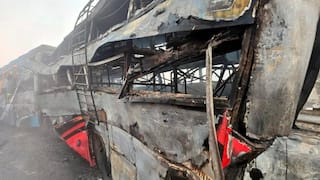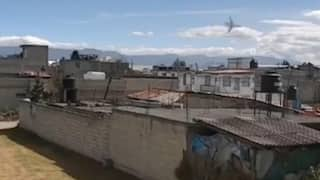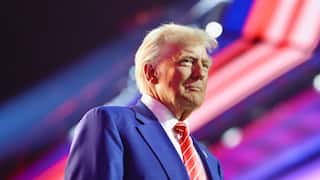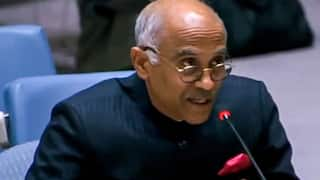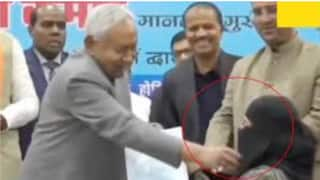Explorer
Who’s Responsible: The WHO, Internationalism, And The Coronavirus Pandemic
The point here is that the WHO may have been somewhat ill-prepared for the 21st century and for the kind of viruses that appear to proliferate partly in consequence of the relentless pressure placed upon the land by large-scale mechanized farming, the substantial decrease and often decimation of the habitats for wildlife, the enormous increase in greenhouse gases, and the increasing incidence in zoonotic diseases.

Representational Image (AFP)
The World Health Organization (WHO), which is today the face of international cooperation—or chaos, some would say—has kicked off yet another controversy as it seeks to lead the world out of the coronavirus pandemic. On June 5, nearly two to three months after public health authorities in most countries had directed people to start wearing masks, the WHO’s embattled Director-General, Dr. Tedros Adhanom Ghebreyesus, announced at a press conference that the organization recommended that people living in areas experiencing “widespread transmission” of COVID-19 adopt a face covering. That it took the WHO this long to issue such a note of guidance controverts the perception that it is supposed to lead not follow countries in adopting measures to deal with a global public health emergency, though its delay in issuing this advice suggests the political difficulties in proposing public health guidelines to countries with varying political systems and differing ideas on how to neutralize and eventually eliminate the threat of COVID-19. But that Dr. Ghereyesus shared such a recommendation suggests also that the WHO holds to the view that there can be asymptomatic transmission of COVID-19, which is all the more reason why a statement made on June 8 by Dr. Maria Van Kerkhove, an American infectious diseases epidemiologist who is the WHO’s technical lead on COVID-19 and head of its emerging disease and zoonosis unit, suggesting that asymptomatic transmission is “very rare” must have appeared to many as bizarre.
ALSO READ: The Killing of George Floyd: Racism in a Country Living on Borrowed Time
If there is no asymptomatic transmission of COVID-19, then obviously many of the guidelines urging social distancing and the use of face masks will appear to have been superfluous; indeed, the shuttering of the world economy would seem to have been unnecessary. There is already a small and increasingly vocal segment of the population in many countries that has questioned the wisdom of lockdown and other similar measures to contain the spread of the virus, and it is unquestionably the case that the “opening up” that we are seeing in many countries, even as in many of them—India, Pakistan, Brazil, Mexico, the United States, Britain, among others—cases continue to rise rapidly, is in consequence of the pressure upon governments to lift restraining orders, have people return to work, and restore some notion of normalcy. On June 9, Dr. Kerkhove appeared to walk back on what many construed as her message of the previous day: as she noted at a press conference, “I did not say that asymptomatic cases cannot transmit; they can. The question is, do they? And if they do, how often is that happening?” A number of research studies appear to suggest that asymptomatic individuals may account for as much as 45% of COVID-19 cases; on the other hand, there are studies which have seemingly established that the asymptomatic transmission rate is at best 2.2%, suggesting that asymptomatic spread is an unlikely driver of community transmission of infection.
What the present controversy has established, in the first instance, is that much about the coronavirus and its transmission still remains unknown. Patients may show only the slightest symptoms; or the symptoms may appear much later, and a patient may have already spread the disease before the manifestation of symptoms: perhaps one might usefully distinguish between pre-symptomatic and asymptomatic cases. “Experts” have been weighing in with advice, but it has been difficult to establish any consensus beyond the desirability of quarantining people who display the symptoms of the disease and the necessity to adopt a simple precautionary gesture such as washing one’s hands with soap frequently. Though the lead has been taken by scientists, and more particularly infectious disease specialists and virologists, in helping the public understand the advance of COVID-19 and the contours of the disease, curiously “science” may have less to contribute in bringing the world out of the coronavirus than elementary public health measures, state policies that are attentive to conflicting demands, the exercise by people of some norms of social responsibility, and prudence.
It is in this context that it becomes necessary to revisit the question of the politics in which the WHO has been mired and the future of an organization which, though it appears to have seen better times, still augurs the possibility of “international cooperation”—“still” because relations between countries have become noticeably frayed and ethno-nationalisms, which were on the rise even before the emergence of COVID-19, seem to point to the tendency of nations to pursue their own political destinies. The WHO was founded in the aftermath of World War as one of many institutions, in this case as one embedded within the United Nations, that were conceived as offering a better future, one less animated by rivalry between nation-states, for humankind. The WHO’s Constitution, passed in 1948, contemplated “the attainment by all people of the highest possible levels of health”, an idea that seemed all the more imperative in view of the deadly toll taken by diseases that, even if they had been “conquered” in the West, continued to terrorize countries in the Global South. In India, as an illustration, life expectancy at the cusp of independence was around 30, not even half of what it was in Australia, Britain, and the United States. Indeed, India had been ravaged by plague, cholera, tuberculosis, smallpox, typhoid, malaria—and, as if all this this was not enough, famine in the period extending from 1875 until the Bengal Famine of the early 1940s. By my own estimation, one can reasonably estimate that excess mortality in late colonial India, in a period of some seven decades, was not less than 100 million and perhaps more likely around 120 million.
The WHO’s first several decades were marked by considerable success. The organization played a significant role in reducing substantially the incidence of yellow fever, but its greatest achievement is undoubtedly the global eradication of smallpox in 1979. The WHO was among the principal organizations that, in 1988, launched the Global Polio Eradication Initiative: it was able to declare the Americas polio-free by 1994, and type 2 poliovirus had been eradicated from India by 1999. Wild poliovirus (WPV) cases in India by early 2003 had come down to fewer than 45 and by 2014 the WHO declared India, where the global eradication program had witnessed its greatest challenges, polio-free. But polio still persisted, though in small numbers, across several other countries. Through the course of the last ten years, there have been a number of WHO initiatives in an attempt to declare the world polio-free though it remains endemic in both Afghanistan and Pakistan, where rumours that the polio vaccine renders females sterile have made full compliance with state efforts to vaccinate everyone difficult. Still, considering that there are fewer than 200 cases worldwide this year, the WHO’s efforts have largely paid off.
However, the WHO’s record in helping contain the transmission of viruses, many of zoonotic origins, that have created global public emergencies over the last two decades and that are quite likely poised to become even more critical in the decades ahead is rather more mixed. It may be that the organization was created with the intention of liberating the world from those diseases that had been the scourge of humankind and whose very name evoked dread: typhoid, malaria, cholera, yellow fever, smallpox. No one was quite thinking of the “plague”, even if the outbreak of pneumonic plague in Surat in 1994 (with bubonic plague discovered in three villages in Maharashtra), was a grimly reminder that this ancient pestilence had by no means disappeared. The incidence of death from the plague in Surat was only 56, and it was soon relegated to the background as an anomaly, as something that was merely an unpleasant reminder of “medieval times” in a modern age that had moved beyond such calamities.
The point here is that the WHO may have been somewhat ill-prepared for the 21st century and for the kind of viruses that appear to proliferate partly in consequence of the relentless pressure placed upon the land by large-scale mechanized farming, the substantial decrease and often decimation of the habitats for wildlife, the enormous increase in greenhouse gases, and the increasing incidence in zoonotic diseases. Nevertheless, the WHO was still able to profit, at least into the early years of the 21st century, by the fact that most countries had not yet succumbed to extreme forms of nationalism and that international organizations still commanded considerable respect. The case of SARS, Severe Acute Respiratory Syndrome, is illustrative of the influence, largely unthinkable today, that the WHO was able to exercise less than 20 years ago. In mid-November 2002, the Chinese government first became aware of cases of SARS, but it failed to report them to WHO. Three months later, the Guangzhou city government was still putting on a bold face in declaring that it had the disease comprehensively under control. But the WHO was in any case on to the fact that something was amiss: the organization’s then Director-General, Gro Harlem Brundtland, had in place a system of rigorous monitoring and the WHO’s staff surmised that an atypical pneumonia outbreak had taken place in China. Brundtland, whose stern and disciplined leadership of the WHO won her some admirers even as it raised a few eyebrows, chastised China for keeping the outbreak a secret, arguing that it could have been contained if the WHO had been brought into the picture and allowed to share its medical expertise. On February 7th, China responded by sending the WHO the first detailed report on the outbreak; thereafter, as the disease spread, China and other countries regularly shared their data with the WHO. Though SARS spread to 29 countries, worldwide fatalities numbered around 800, with China and Hongkong alone accounting for 75% of the deaths.
The WHO had played its part in containing SARS, but its role in subsequent crises, according to some critics, is far more questionable. It declared the H1N1 “swine flu” of 2009 a “pandemic”—the first time it did so under revised international protocols—and was heavily criticized by many countries for having over-reacted. Perhaps, chastened by this experience, it may have taken too long to send an international health warning to other countries after the Ebola outbreak in West Africa in 2014. But these controversies may pale into insignificance in comparison with the storm that has been brewing over the WHO’s role in the present coronavirus pandemic. In early April, President Trump let loose a volley of highly critical remarks blaming the WHO for having withheld information about COVID-19 from the US (and the rest of the world, though it need not be said that Trump cares not an iota for other countries), and thereby holding it just as responsible as China for the rapid spread of the disease around the world. In subsequent remarks, Trump threatened to withhold US funding from the WHO: no small matter this, considering both that the WHO has to call upon all its resources to fight the pandemic and that the US makes the largest contribution among member states to the organization. Sentiment against the WHO runs very high among many Republican lawmakers, who have long complained that China gets a free hand in bullying other nations and international organizations alike, and the feeling is widespread among them, and other critics of the UN and its agencies, that WHO was far too willing to pander to China. That the United States is not singular in taking this view is clear from the fact that the Japanese Deputy Prime Minister and Finance Minister, Taro Aso, noted scathingly that many people were referring to the World Health Organization as the “Chinese Health Organization”.
If Beijing sought to keep knowledge of SARS from the rest of the world, its credibility in the present pandemic is obviously questionable. The supposition, on the part of the United States, is that the WHO abetted China in disguising some known facts about COVID-19, more particularly the question of whether human-to-human transmission of the virus was possible. The WHO continued to deny publicly that such transmission was possible as late as 14 January 2020, as its tweet of that day made clear, but by January 24 the Chinese government had sealed off the entire province of Hubei, which has a population of 50 million, and thereby signaled to the world that COVID-19 does indeed transmit from one person to another. The WHO now had to make a call: should it declare COVID-19 a “public health emergency of international concern” (PHEIC)? Its emergency committee met on January 22 but the committee was split down the middle: though the United States has declared the WHO complicit with China, it was represented on the 15-member committee along with representatives of many of its allies, including New Zealand, Australia, Sweden, France, Canada, The Netherlands, Japan, South Korea, Singapore, and Saudi Arabia. Indeed, only Russia among the committee’s members can be counted as hostile to the US: evidently, then, at least some of the US’s friends were against the decision to designate COVID-19 an international public health emergency (PHEIC). However, in an attempt to forge a unanimous opinion, Director-General Ghebreyesus did not go public with the committee’s decision and ordered it to reconvene the following day, with similar results. It wouldn’t be until January 29 that the WHO would declare the coronavirus a PHEIC—a far more critical decision than its decision, six weeks later, to designate it a “pandemic”.
The evidence on whether the WHO acted decisively, and early enough, in sounding a warning to the world about the origins, modes of transmission, and advance of COVID-19 remains inconclusive. But, whatever position one might adopt, what is incontrovertibly true is that the United States, and similarly countries such as the UK and Brazil, did not take the threat seriously for weeks after the WHO had declared that there was a public health emergency of international concern. Consequently, the debate over the WHO should be recognized for what it is, namely a form of scapegoating. A pure narcissist such as Trump has no other interest at the moment besides trying to ensure his electoral triumph this November, and it is imperative that one recognize the much larger considerations that are raised by the present controversy over the WHO. The real question revolves around the future of international organizations considering that nations are increasingly veering towards authoritarian populism, mindful only of some of their constituents at home, and that disdain for international opinion in many countries is all too visible. Can new forms of “internationalism” emerge in the wake of COVID-19 that take the place of organizations such as the WHO that superficially appear to be supra-national but are, in actuality, entirely built upon the notion of the nation-state as the ultimate expression of human community? The speculations that one might entertain about such possibilities are, however, the subject for another essay.
(Vinay Lal is a writer, blogger, cultural critic, and Professor of History at UCLA)
Disclaimer: The opinions, beliefs and views expressed by the various authors and forum participants on this website are personal and do not reflect the opinions, beliefs and views of ABP News Network Pvt Ltd.
Follow Blog News on ABP Live for more latest stories and trending topics. Watch breaking news and top headlines online on ABP News LIVE TV
View More












